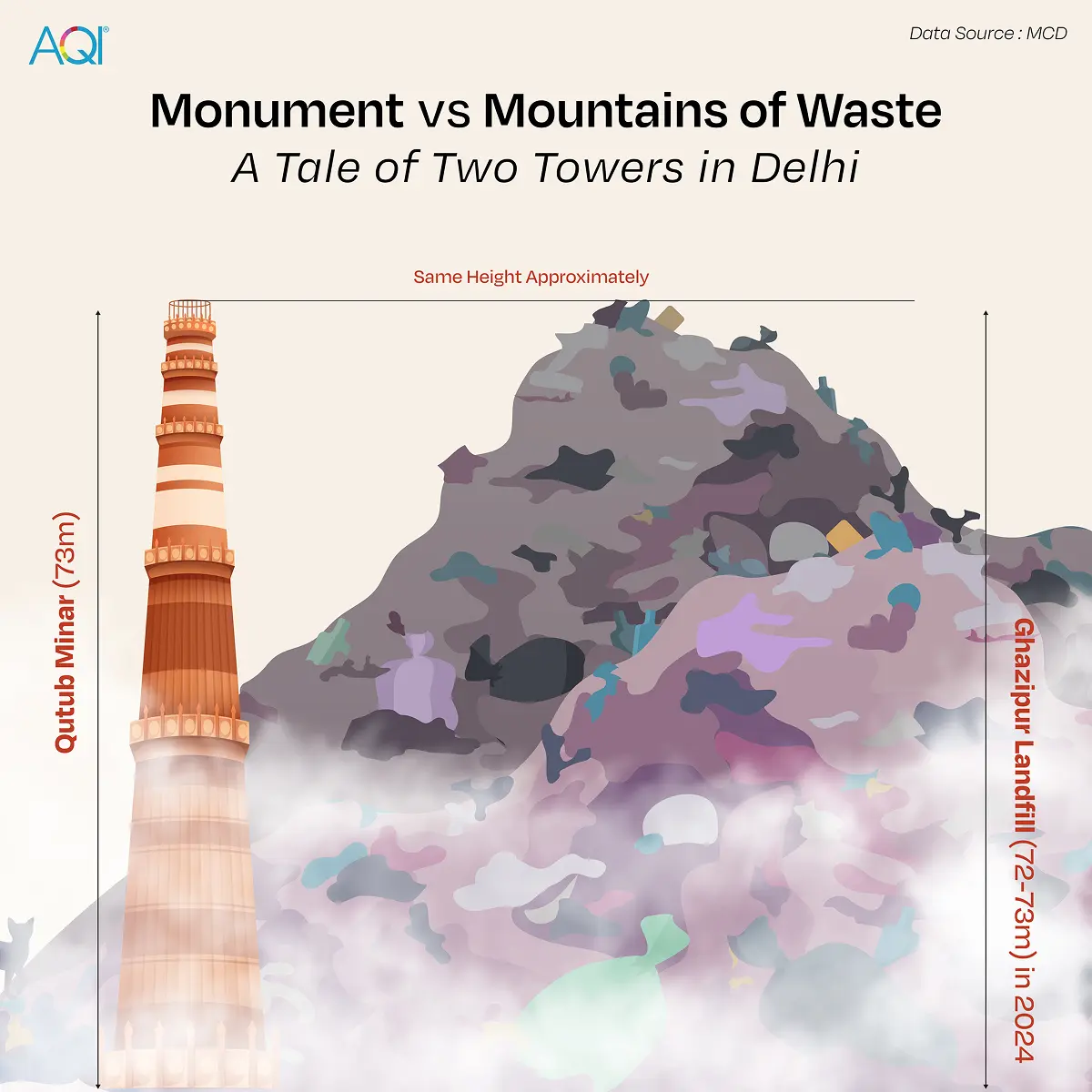Over 30 million residents of Delhi are forced to inhale dangerous gases such as methane. But where is this hazardous gas coming from? Delhi has three major landfills—Ghazipur, Bhalswa, and Okhla—which have been identified as significant sources of methane emissions. Moreover, the size of these landfills continues to expand each day. Let’s take a closer look at the methane emissions from Delhi’s landfills in detail.
Why Methane Emissions from Delhi’s Landfills Are a Growing Problem?
Delhi’s landfills—Ghazipur, Bhalswa, and Okhla—are like giant garbage mountains, some as tall as the Qutub Minar (73 meters). They’re leaking methane, a harmful gas that makes climate change worse. Every day, Delhi dumps over 10,000 tonnes of waste, with 50-55% being food scraps and other biodegradable stuff that rots and releases methane. Since 2020, satellites have spotted 124 major methane leaks, including a massive one from Ghazipur in 2021, leaking 156 tonnes per hour—that’s like the pollution from 24 million cars running at once!
What is Methane?
is an invisible, odourless gas produced when organic waste (like food or plant matter) rots without oxygen, which happens a lot in Delhi’s packed landfills. It’s a greenhouse gas, 82 times more powerful than carbon dioxide (CO2) at trapping heat over 20 years, making our planet hotter. While methane itself isn’t directly toxic to breathe in small amounts, it often comes with other harmful pollutants from landfills, especially during fires, which worsen air quality and health.
How Methane Emissions from Delhi’s Landfills Affect Health?
Methane from landfills doesn’t just float away—it causes problems right here in Delhi:

- Toxic Fumes from Fires: In summer, landfills catch fire due to methane buildup, releasing smoke and pollutants like PM2.5 (tiny particles that get into your lungs). A 2022 Bhalswa fire increased PM2.5 levels by 45-55%, making Delhi’s air even more dangerous.
- Breathing Issues: People near landfills, like Ghazipur residents, complain of coughing, breathlessness, and sore throats, especially during fires. Mohammad Rizwan, a shop owner near Ghazipur, said, “It’s impossible to breathe, and everyone gets sick because of the bad fumes and smoke”.
- Long-term Risks: Constant exposure to landfill pollutants can lead to asthma, lung infections, or even heart problems, especially for kids and the elderly living nearby.
Ghazipur Landfill vs. Qutub Minar
Picture the Qutub Minar, Delhi’s 73-meter-tall heritage monument, standing tall in Mehrauli. Now imagine the Ghazipur landfill in East Delhi, a towering pile of garbage reaching a similar height, around 72-73 meters, as reported in 2024. Unlike the Qutub Minar, which draws tourists, Ghazipur’s “trash tower” spews methane and toxic smoke, making life miserable for nearby residents. Growing since 1984, this landfill handles thousands of tonnes of waste daily, and its height is a stark reminder of decades of poor waste management.

Why Should Delhiites Care About Methane Emissions from Delhi’s Landfills?
If you live in Delhi or nearby areas like Noida or Gurugram, this affects you. The smoke and stench from landfills make daily life harder, especially in summer when fires are common. Plus, methane adds to global warming, which means hotter summers and worse monsoons for all of us. Delhi’s air quality is already among the worst, and landfills make it tougher to breathe clean air.
What’s Being Done?
The government promised to clear these landfills by 2024, but the deadline is now still due to slow progress. They’re trying:
- Bio-mining: Digging up old waste to recycle or process it.
- New Landfills: An engineered landfill in Tehkhand opened in 2024 to manage waste better. But challenges like poor waste segregation (mixing wet and dry waste) and lack of composting facilities keep the problem alive.
What Can You Do?
You don’t need to be an expert to help—just start at home:
- Separate Your Waste: Keep food scraps (wet waste) separate from plastic and paper (dry waste). This reduces methane-producing waste in landfills.
- Compost at Home: Turn kitchen waste into compost for your plants. It’s easy and cuts down landfill waste.
- Spread the Word: Talk to your neighbours or RWAs about proper waste disposal. Small changes in your colony can make a big difference.
A Relatable Example
Think of Delhi’s landfills like a giant, smelly kitchen dustbin left unemptied for years. The rotting food inside produces methane, and when it “catches fire,” it’s like burning trash in your backyard—smoke everywhere, making it hard to breathe. Now imagine doing something simple, like emptying the bin daily or composting the scraps. That’s how we can tackle this problem together.
The Bottom Line
Delhi’s landfills are leaking methane, making our air dirtier and our planet hotter. It’s not just a government problem—it’s personal. By segregating waste and composting, you can help clear the air and make Delhi a healthier place to live. Let’s do our part to stop this invisible threat!